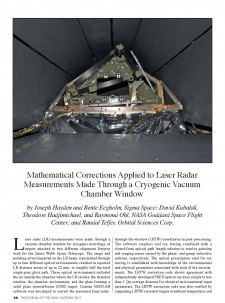
|
Download Members: $0.00 Non‑Members: $75.00 |
Buy Now |
Publication Details
| Published Date: | |
|---|---|
| Authors: | Joseph Hayden, Bente Eegholm, David Kubalak, Theodore Hadjimichael, Raymond Ohl, Randal Telfer |
| Company: | CMSC |
| Print Format: | Technical Paper |
| Citation: | Joseph Hayden, Bente Eegholm, David Kubalak, Theodore Hadjimichael, Raymond Ohl, Randal Telfer, "Mathematical Corrections Applied to Laser Radar Measurements Made Through a Cryogenic Vacuum Chamber Window," The Journal of the CMSC, Vol. 6, No. 2, Autumn 2 |
Abstract
Laser radar (LR) measurements were made through a vacuum chamber window for cryogenic metrology of targets attached to two different alignment fixtures used for the James Webb Space Telescope. The range and pointing errors imparted on the LR beam, transmitted through up to four different optical environments, resulted in reported LR distance errors of up to 22 mm, or roughly half the total single-pass glass path. These optical environments included the air outside the chamber where the LR resides, the chamber window, the chamber environment, and the glass forming a solid glass retroreflector (SGR) target. Custom MATLAB software was developed to correct the measured laser-radar-through-the window (LRTW) coordinates in post-processing. The software employs a real ray tracing solution to resolve pointing and ranging errors caused by the phase- and group-refractive indexes, respectively. The optical prescription used for ray tracing is established with knowledge of the environmental and physical parameters associated with each of the environments. The LRTW correction code shows agreement with independently developed FRED optical ray trace scripts to less than 1 mm average distance for identical environmental input parameters. The LRTW correction code was also verified by comparing LRTW-corrected targets at ambient temperature and pressure on the JWST alignment fixtures to those same targets when measured with no window in place. The resulting average distance error was less than 30 mm (2 sigma), which is consistent with LR-related sources of measurement error for this last configuration. The LRTW coordinate correction software could also be used “in reverse” to calculate apparent target locations for LR measurements made through a window given the blueprint or nominal values of those targets. This capability is useful for allowing the LR to quickly locate targets measured through a window or when setting up scan boundaries around poorly illuminated distant targets. This LRTW correction capability has also recently been extended to use with laser trackers.






